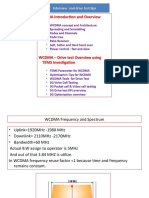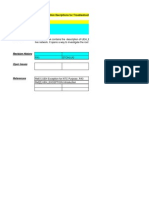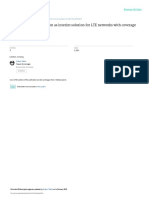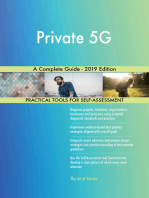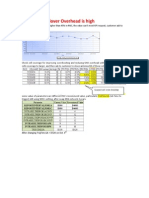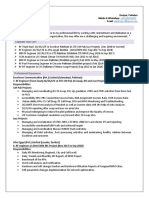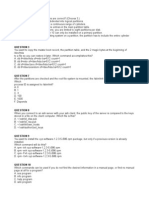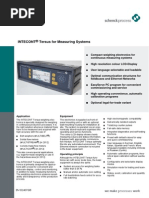0 ratings0% found this document useful (0 votes)
80 views2G CSSR Improvement
2G CSSR Improvement
Uploaded by
Zeeshan AkhtarThe document provides steps to improve 2G and 3G CSSR by addressing potential blocking issues. For 2G, it suggests checking for hardware issues, adjusting SD blocking and tuning parameters. For 3G, it recommends ensuring no blocking of resources like codes, power, CEs or IUBs and provides optimization steps for each including adjusting thresholds, upgrading hardware and modifying parameters. It also mentions adjusting CPICH power, activating EFD and adjusting the QQUALMIN parameter to further improve CSSR.
Copyright:
© All Rights Reserved
Available Formats
Download as DOCX, PDF, TXT or read online from Scribd
2G CSSR Improvement
2G CSSR Improvement
Uploaded by
Zeeshan Akhtar0 ratings0% found this document useful (0 votes)
80 views3 pagesThe document provides steps to improve 2G and 3G CSSR by addressing potential blocking issues. For 2G, it suggests checking for hardware issues, adjusting SD blocking and tuning parameters. For 3G, it recommends ensuring no blocking of resources like codes, power, CEs or IUBs and provides optimization steps for each including adjusting thresholds, upgrading hardware and modifying parameters. It also mentions adjusting CPICH power, activating EFD and adjusting the QQUALMIN parameter to further improve CSSR.
Original Title
CSSR
Copyright
© © All Rights Reserved
Available Formats
DOCX, PDF, TXT or read online from Scribd
Share this document
Did you find this document useful?
Is this content inappropriate?
The document provides steps to improve 2G and 3G CSSR by addressing potential blocking issues. For 2G, it suggests checking for hardware issues, adjusting SD blocking and tuning parameters. For 3G, it recommends ensuring no blocking of resources like codes, power, CEs or IUBs and provides optimization steps for each including adjusting thresholds, upgrading hardware and modifying parameters. It also mentions adjusting CPICH power, activating EFD and adjusting the QQUALMIN parameter to further improve CSSR.
Copyright:
© All Rights Reserved
Available Formats
Download as DOCX, PDF, TXT or read online from Scribd
Download as docx, pdf, or txt
0 ratings0% found this document useful (0 votes)
80 views3 pages2G CSSR Improvement
2G CSSR Improvement
Uploaded by
Zeeshan AkhtarThe document provides steps to improve 2G and 3G CSSR by addressing potential blocking issues. For 2G, it suggests checking for hardware issues, adjusting SD blocking and tuning parameters. For 3G, it recommends ensuring no blocking of resources like codes, power, CEs or IUBs and provides optimization steps for each including adjusting thresholds, upgrading hardware and modifying parameters. It also mentions adjusting CPICH power, activating EFD and adjusting the QQUALMIN parameter to further improve CSSR.
Copyright:
© All Rights Reserved
Available Formats
Download as DOCX, PDF, TXT or read online from Scribd
Download as docx, pdf, or txt
You are on page 1of 3
2G CSSR Improvement:
1. Check for HW Issues
2. SD Blocking (Increase SD channels)
3. Remove SD Blocking ( cause by interference mainly)
4. Overshooting control
5. Tuning Parameters (RxlevAccessMin,T200 etc)
6. TRX layering
3G CSSR Improvement
Make sure no Blocking resources: Code,Power,CE,IUB
As we know in 3G WCDMA there are some resources like Code,Power,CE(Channel Element) and IUB.
You have to make sure no blocking resources first to improve your CSSR. If you found some blocking
based on your counter then you have to optimize. Here are some suggestion step to optimize blocking
resources:
1. Code Blocking Optimization step:
1st action step: Physical Audit (involving TP analysis) : Make sure no overlap/overshooting coverage
2nd Action: Modify DLHOCECODERESVSF to lower SF (e.g from SF32 to SF 64)
3rd Action: Reduce HSPDSCHMINCODENUM (e.g from 5 to 4)
4th Action: Reduce HSSCCHCODENUM (e.g from 4 to 3)
2. Power Blocking Optimization Step:
- UL- Power Blocking
1st Action: Physical Audit (involving TP analysis)
2nd Action: Increase ULTOTALEQUSERNUM (e.g from 160 to 180)
3rd Action: Turn-off NBMULCACALGOSELSWITCH (set to ALGORITHM_OFF)
- DL- Power Blocking/DL - Power High Util
1st action: Physical Audit (involving TP analysis)
2nd Action: Activate 40W, maintain existing PCPICH setting
Step activate 40W in Huawei System:
- Block board with script: BLK BRD:CN=1,SRN=4,SN=x;
- Remove Locell for 2nd carrier in nodeb with script : RMV LOCELL:LOCELL=x;
- Add Locell on 2nd carrier with script:
ADD
LOCELL:LOCELL=x,STN=x,SECN=x,SECT=LOCAL_SECTOR,ULGROUPNO=0,DLGROUPNO=0,
TTW=FALSE,CN1=1,SRN1=4,SN1=x,ANT1N=ANTB,ULFREQ=9638,DLFREQ=10588,MXPWR=46
0,HISPM=FALSE,RMTCM=FALSE,VAM=FALSE;
- Modify Power to 40 W for 1st carrier with script: MOD
LOCELL:LOCELL=x,SECT=LOCAL_SECTOR,MXPWR=460;
- Unblock Board with script: UBL BRD:CN=1,SRN=4,SN=x;
- Modify MAXTXPOWER in RNC level for F1 dan F2 with script: MOD
UCELL:CELLID=x,MAXTXPOWER=460;
- Check site Up or not with script: DSP UCELL:DSPT=BYNODEB,NODEBNAME="x";
3rd Action: Modify DL CAC parameters set to higher value. Parameters involved : DLCONVAMRTHD,
DLCONVNONAMRTHD, DLOTHERTHD, DLHOTHD, DLCELLTOTALTHD
3. CE Blocking Optimization Step:
1st action: Verify CE license and CE board capability. Commands involved : DSP LICENSE, DSP
BBPTC(Huawei LMT)
2nd Action: Physical Audit (involving TP analysis)
3rd Action: CE license and/or board upgrade
4th action: Modify LDR threshold. Sets involved : UCELLLDM, UCELLLDR
4. IUB Blocking Optimization Step:
1st Action: Verify Iub BW setting in Node-B and in RNC. Sets involved : IPPATH, IPLOGICPORT
2nd Action: Physical Audit (involving TP analysis)
3rd Action: Iub BW upgrade
4th action: Modify FTI to reduce Active Factor. Sets involved : TRMFACTOR, ADJMAP, ADJNODE
- Make Sure no Hardware Issue:
Hardware issue or wrong installation can be impacted to low CSSR such as WRFU problem or bad
connector installation. You have to make sure no such hardware problem to make your CSSR good.
- Make Sure no Overshooting Coverage
As stated on resources optimization, you need to make sure no overshooting or coverage overlap to make
your CSSR is good and no handle unnecessary traffic and make nodeB handle traffic heavily.
- Activate EFD(Enhanced Fast Dormancy) Feature
When fast dormancy, enhanced fast dormancy, or standard fast dormancy is applied, the UE can request
the RNC to release the PS signaling connection if no more PS data is being transmitted. Upon receiving
such a request, the RNC can either release the signaling connection and put the UE into idle mode, or
maintain the signaling connection and put the UE through Cell_FACH to CELL/URA_PCH state to
reduce battery consumption. The descriptions about fast dormancy, enhanced fast dormancy, and standard
fast dormancy are as follows:
- With fast dormancy, after receiving a Signaling Connection Release Indication (SCRI) message from a
UE, the RNC releases the UE RRC connection regardless of whether the message contains the cause
value "UE Requested PS Data session end."
- With enhanced fast dormancy, UEs send SCRI messages that do not contain the cause value "UE
Requested PS Data session end" to the RNC. After receiving such an SCRI message, the RNC moves
the UE through Cell_FACH to CELL/URA_PCH state.
- Standard fast dormancy is applicable to fast dormancy UEs that comply with 3GPP Release 8 (R8 for
short). With standard fast dormancy, UEs send SCRI messages that contain the cause value "UE
Requested PS Data session end" to the RNC. After receiving such an SCRI message, the RNC moves
the UE through Cell_FACH to CELL/URA_PCH state. Standard fast dormancy is valid only when
theRNC has enabled the timer T323 in system information block type 1 (SIB1). You can refer to the
document on your vendor to activate EFD feature.
- Adjust CPICH Power Setting
You can adjust CPICH Power setting to reduce coverage and improve your CSSR Ex:
Change PCPICHPOWER from 330 to 300.
- Adjust Parameter QQUQALMIN
You can adjust QQUALMIN to improve CSSR and avoid congestion on blocking resources especially
during event with potential to increasing traffic. Example: Change Qqualmin from -18 to -15 to avoid
congestion.
You might also like
- TCH & SDCCH Congestion AnalysisDocument4 pagesTCH & SDCCH Congestion AnalysisAbdur RazzaqeNo ratings yet
- UMTS CongestionDocument3 pagesUMTS CongestionAkhtar Khan67% (3)
- Source Email Worm - win32.Skybag.ADocument58 pagesSource Email Worm - win32.Skybag.AetiennekraemerNo ratings yet
- Paging Procedures in UMTSDocument2 pagesPaging Procedures in UMTSYasir ShafiqNo ratings yet
- Lte Random Access ProcedureDocument5 pagesLte Random Access ProcedureVarun VermaNo ratings yet
- KPIDocument7 pagesKPIKunal GuptaNo ratings yet
- What Is TBFDocument295 pagesWhat Is TBFAnudeep Bhattacharya100% (1)
- ZTE Signaling FlowDocument40 pagesZTE Signaling FlowpandiarajvimalNo ratings yet
- Key Performance IndicatorsDocument26 pagesKey Performance IndicatorsBryanNo ratings yet
- 3 WCDMA HandoverDocument105 pages3 WCDMA HandoverDeiz SovieNo ratings yet
- TTI BundlingDocument5 pagesTTI BundlingMilind Gunjan100% (1)
- GPRS/EDGE DT AnalysisDocument11 pagesGPRS/EDGE DT AnalysisSiavash SalarzehiNo ratings yet
- Tems InvestigationDocument12 pagesTems InvestigationMinto IssacNo ratings yet
- 3G Optimization Interview Topics SYAFRIZALDocument9 pages3G Optimization Interview Topics SYAFRIZALvishalkavi18No ratings yet
- PCI Planning Strategies For Long Term Evolution NetworksDocument6 pagesPCI Planning Strategies For Long Term Evolution Networkspraving5005No ratings yet
- 3g Drive Test LearningDocument31 pages3g Drive Test LearningGautam Kumar100% (1)
- T-Cell Concept in WCDMADocument8 pagesT-Cell Concept in WCDMAsalman nazir67% (3)
- Basic UEH ExceptionDocument32 pagesBasic UEH ExceptionAhmed ZeharaNo ratings yet
- RRC Conn Release (With Redirection and W - o Redirection) - LinkedInDocument5 pagesRRC Conn Release (With Redirection and W - o Redirection) - LinkedInsukanganulhoNo ratings yet
- Huawei CHR FaqDocument4 pagesHuawei CHR FaqSiddharth JainNo ratings yet
- 1 LTE eRAN6.0 Handover Fault DiagnosisDocument48 pages1 LTE eRAN6.0 Handover Fault Diagnosisfaysal137152.storageNo ratings yet
- UMTS PagingDocument2 pagesUMTS PagingCauTungNo ratings yet
- Cell Load Sharing (CLS)Document3 pagesCell Load Sharing (CLS)Minto IssacNo ratings yet
- Introduction To LTE Device TestingDocument76 pagesIntroduction To LTE Device TestingAdnan Dizdar100% (1)
- 3G KPI Benchmark With FormulaDocument12 pages3G KPI Benchmark With FormulaAnudeep BhattacharyaNo ratings yet
- ERAN3.0 DRX Parameters v1.0Document17 pagesERAN3.0 DRX Parameters v1.0testNo ratings yet
- RNO ParameterDocument29 pagesRNO ParameterAmitabh MishraNo ratings yet
- SIB2Document5 pagesSIB2moslemNo ratings yet
- LogsDocument684 pagesLogsRamyaranjan BarikNo ratings yet
- 3G Sib & MibDocument5 pages3G Sib & MibnitinNo ratings yet
- ALU - UMTS QoS and Performance MonitoringDocument102 pagesALU - UMTS QoS and Performance MonitoringIvan Milutinovic100% (1)
- Layer 3 - Umts PDFDocument49 pagesLayer 3 - Umts PDFSukrit Chaudhary100% (6)
- 3G Measurement Report EventsDocument8 pages3G Measurement Report EventsAngga MaschioNo ratings yet
- GSM Layer 3 MessagesDocument47 pagesGSM Layer 3 MessagesKrishnakumar VoletiNo ratings yet
- Lte Erab Setup Phase Description and Common Failures PDFDocument8 pagesLte Erab Setup Phase Description and Common Failures PDFjoseNo ratings yet
- LTE Attach Procedure Message Flow (S5/S8 GTP Based) : UE eNB MME HSSDocument7 pagesLTE Attach Procedure Message Flow (S5/S8 GTP Based) : UE eNB MME HSSdiditNo ratings yet
- S3 1 3VoLTEOptimizationIEEEDocument6 pagesS3 1 3VoLTEOptimizationIEEEnewshaNo ratings yet
- 3GPP ReleaseDocument149 pages3GPP ReleaseAjay Vachhani100% (1)
- RAN17 SignalingDocument156 pagesRAN17 SignalingNinh Văn TrưởngNo ratings yet
- LTE Timing AdvanceDocument17 pagesLTE Timing Advanceraviranjan1975No ratings yet
- Fast CS Fallback Based On RIM Feature Parameter DescriptionDocument12 pagesFast CS Fallback Based On RIM Feature Parameter DescriptionelatbarawiNo ratings yet
- CSFB Vs EcsfbDocument30 pagesCSFB Vs Ecsfbgolden_hunter_1980No ratings yet
- LTE Self-Organising Networks (SON): Network Management Automation for Operational EfficiencyFrom EverandLTE Self-Organising Networks (SON): Network Management Automation for Operational EfficiencySeppo HämäläinenNo ratings yet
- CSSR ImprovementDocument3 pagesCSSR ImprovementmazenNo ratings yet
- CSSR Optimization For GSM and WCDMADocument30 pagesCSSR Optimization For GSM and WCDMAmosesNo ratings yet
- LTE Deep Concept Part1Document26 pagesLTE Deep Concept Part1saifullahNo ratings yet
- UMTS FundamentalsDocument75 pagesUMTS Fundamentalsfaxdi123456No ratings yet
- M2000 3G MML CommandDocument23 pagesM2000 3G MML CommandHerry Martin SimamoraNo ratings yet
- UMTS Interview Questions and AnswerDocument16 pagesUMTS Interview Questions and AnswerSuhelSiddiquiNo ratings yet
- WcdmaDocument102 pagesWcdmaعبدالرحمن دقداق91% (11)
- TTCN For CT (Utran) 1 - 0Document32 pagesTTCN For CT (Utran) 1 - 0chiragdhyaniNo ratings yet
- Step Replace Module Flexi BSC NokiaDocument19 pagesStep Replace Module Flexi BSC Nokiarudibenget0% (1)
- 3G UMTS CS&PS Drop Call RateDocument2 pages3G UMTS CS&PS Drop Call RateDone LatsithongNo ratings yet
- NDocument1 pageNZeeshan AkhtarNo ratings yet
- Sum of TCH TrafficDocument1 pageSum of TCH TrafficZeeshan AkhtarNo ratings yet
- Bannu Unblocking - 24th - JuneDocument11 pagesBannu Unblocking - 24th - JuneZeeshan AkhtarNo ratings yet
- 3G U2100Document10 pages3G U2100Zeeshan AkhtarNo ratings yet
- Zeeshan Akhtar Resume UpdatedDocument3 pagesZeeshan Akhtar Resume UpdatedZeeshan AkhtarNo ratings yet
- Sajid Khan: Career HistoryDocument4 pagesSajid Khan: Career HistoryZeeshan AkhtarNo ratings yet
- IT Essentials v5.0 Chapter 1 Exam AnswersDocument9 pagesIT Essentials v5.0 Chapter 1 Exam AnswersAgus TedyNo ratings yet
- 3G RNC Node B Radio Access EngineerDocument4 pages3G RNC Node B Radio Access EngineerSaidul Islam100% (2)
- Chapter 4 - Firewall Security PoliciesDocument35 pagesChapter 4 - Firewall Security Policiespalesamohalla31No ratings yet
- PFSPDS - 016 - EN-2002 - External PowerSafe TAP 3296Document3 pagesPFSPDS - 016 - EN-2002 - External PowerSafe TAP 3296James WangNo ratings yet
- Chap 5 Ed 2 July 02Document143 pagesChap 5 Ed 2 July 02shivaspyNo ratings yet
- What Is Computer?Document9 pagesWhat Is Computer?Gabriel AbrahamNo ratings yet
- 02 FTTX System OverviewDocument99 pages02 FTTX System OverviewElectrotel100% (1)
- Social Network Influence On YouthDocument3 pagesSocial Network Influence On YouthKhairun NisaNo ratings yet
- PresenatationDocument27 pagesPresenatationRaunak PatilNo ratings yet
- Provincial Department of Education, Northern Province:, Uz L KZPJ JpahykDocument13 pagesProvincial Department of Education, Northern Province:, Uz L KZPJ JpahykMac NonashanNo ratings yet
- question bankDocument2 pagesquestion bankSOURAVNo ratings yet
- 3 Designer ManualDocument229 pages3 Designer ManualbukubukuNo ratings yet
- Outlines: Services Offered by BSNL Types of Exchanges Layout of Exchanges RefrencesDocument22 pagesOutlines: Services Offered by BSNL Types of Exchanges Layout of Exchanges RefrencesShivam SinghNo ratings yet
- Introduction To IP Multicast PDFDocument121 pagesIntroduction To IP Multicast PDFHieuNBNo ratings yet
- Ncla QDocument13 pagesNcla Qepy90No ratings yet
- MIPI C PHY Introduction From Basic To ImplementationDocument38 pagesMIPI C PHY Introduction From Basic To ImplementationvikiNo ratings yet
- Overview of CISCO FIREWALLDocument42 pagesOverview of CISCO FIREWALLAlo ChayaNo ratings yet
- Device Expert HelpDocument86 pagesDevice Expert Helpiwc2008007No ratings yet
- Junos Multicast Protocols User GuideDocument2,624 pagesJunos Multicast Protocols User GuidePing Ming ChanNo ratings yet
- Meek Sweater & Fashions LTDDocument3 pagesMeek Sweater & Fashions LTDshoyeb100% (1)
- INTECONT® Tersus For Measuring Systems: % Compact Weighing Electronics ForDocument4 pagesINTECONT® Tersus For Measuring Systems: % Compact Weighing Electronics Forgnazareth_100% (2)
- Cloud ArchitectureDocument36 pagesCloud ArchitectureAkhilesh SinghNo ratings yet
- Malay MSFCDocument95 pagesMalay MSFCMalay KarNo ratings yet
- Sim7022 Spec en 20221020Document2 pagesSim7022 Spec en 20221020Spider hate bugsNo ratings yet
- ICANN and LegitimacyDocument74 pagesICANN and LegitimacyestelauNo ratings yet
- 3.11.1 Packet Tracer Network Security Exploration Physical ModeDocument7 pages3.11.1 Packet Tracer Network Security Exploration Physical ModeirfanNo ratings yet
- Location Awareness PGDocument91 pagesLocation Awareness PGturkitoNo ratings yet
- Revised Bill of MaterialsDocument1 pageRevised Bill of Materialsanon_971974432No ratings yet
- Analysis Xss Exploitation Threat AdvisoryDocument6 pagesAnalysis Xss Exploitation Threat AdvisoryRohit KashmiraNo ratings yet

















